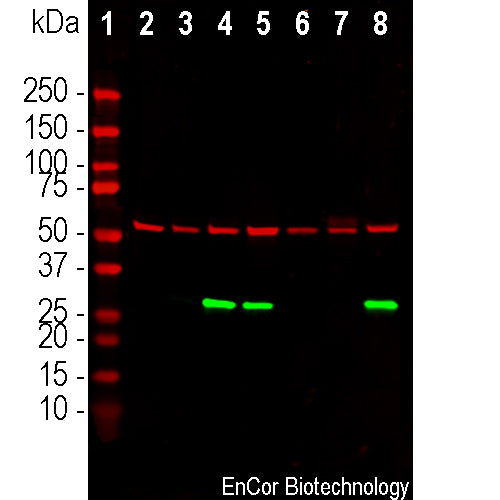

EnCor Biotechnology
Mouse Monoclonal Antibody to Annexin A5, Cat# MCA-6A12
Description
The MCA-6A12 antibody was made against full length recombinant human annexin A5 expressed in and purified from E. coli. The antibody is specific for human annexin A5 and does not recognize annexin A5 in rodents and many other mammals, although it does recognize annexin A5 in COS1 cells which originated from African green monkey. The antibody works well for western blotting and for IF, ICC and IHC of human material (see data under "Additional Data" tab). We also market a rabbit polyclonal antibody to annexin A5 which has a much wider cross-species reactivity RPCA-ANXA5.
Add a short description for this tabbed section
| Immunogen: | Full length human recombinant annexin A5 expressed in and purified from E. coli. |
| HGNC Name: | ANXA5 |
| UniProt: | P08758 |
| Molecular Weight: | 35kDa |
| Host: | Mouse |
| Isotype: | IgG1 |
| Species Cross-Reactivity: | Human, Monkey |
| RRID: | AB_2861177 |
| Format: | Protein G affinity purified antibody at 1mg/mL in 50% PBS, 50% glycerol plus 5mM NaN3 |
| Applications: | WB, ICC/IF, IHC |
| Recommended Dilutions: | WB: 1:2,000-1:5,000. ICC/IF, and IHC: 1:1,000-2,000. |
| Storage: | Store at 4°C for short term, for longer term store at -20°C. Stable for 12 months from date of receipt. |
The annexins are a large family of related proteins which share the property of binding to phophospholipid containing membranes in a Calcium dependent manner (1). Different members of the family were discovered by different laboratories and as a result the various members have many alternate names, such as lipocortin, calpactin, calelectrin and others. In fact Annexin A5 has a particularly surprising number of alternate names, 20 being listed on the Genecards ANXA5 site. The widely used current nomenclature is now based on a letter to indicate membership in a particular one of several annexin sub-families and a number for individual gene products, hence the name annexin A5. The annexin family is defined by a compact disc structure formed from 16 closely packed α-helices which coordinate multiple calcium ions with phospholipid containing membranes. This domain is defined by 4 imperfect repeats of a ~77 amino acid sequence, each repeat forming 4 α-helices (2,3). Annexin A5 is expressed widely in tissues and has been used as a marker of apoptosis, as apoptotic cells may express binding sites for this protein on their cell surface. The protein binds to phosphatidylserine, a membrane lipid normally not found on the external surface of cells which becomes expressed on the cell surface during apoptosis. As a result fluorescent annexin A5 or annexin A5 antibody can be used to isolate apoptotic cells by fluorescence activated cell sorting (4).

Chromogenic immunostaining of a formalin fixed paraffin embedded human cerebellum section with mouse mAb to annexin A5, MCA-6A12, dilution 1:1,000, detected with DAB (brown) using the the Vector Labs ImmPRESS method and reagents with citrate buffer retrieval. Hematoxylin (blue) was used as the counterstain. This antibody performs well in testing with standard NBF fixation but was not tested in 4%PFA fixed tissues. Mouse select image for larger view.
1. Gerke V, and Moss SE. Annexins: from structure to function. Physiol Revs 82:331-71 (2002).
2. Barton GJ. et al. Amino acid sequence analysis of the annexin super-gene family of proteins. Eur J Biochem 198:749-60 (1991).
3. Geisow MJ. et al. A consensus amino-acid sequence repeat in Torpedo and mammalian Ca2+-dependent membrane-binding proteins. Nature 320:636-8 (1986).
4. Koopman G. et al. Annexin V for Flow Cytometric Detection of Phosphatidylserine Expression on B Cells Undergoing Apoptosis. Blood 84:1415-1420 (1984).
Add a short description for this tabbed section





